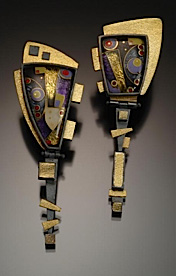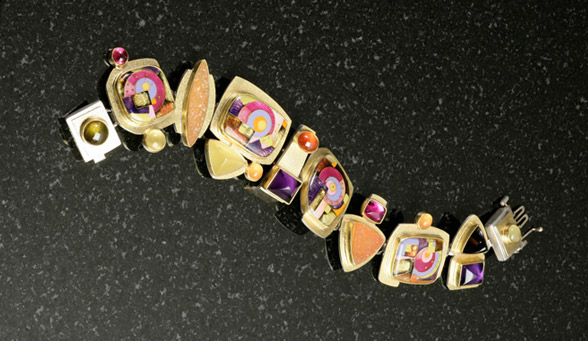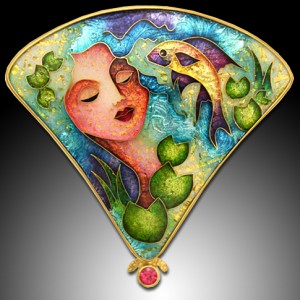
If metalsmiths are the sculptors of the jewelry world, attracted to form and texture, enamellists are the painters, obsessed with color and line. Gemstones can be part of their palette, a way to extend, highlight and balance the enamelwork.
They can also clash, compete and draw attention away from it. Is it any wonder that many enamel jewelry designers have a love-hate relationship with gems?
Many enamel artists think of the stone-setting part of their jewelry as a sort of glorified framing—not particularly creative. After all, the stone was ready-made, they’re merely rendering it wearable. Some think of gemstones as a shortcut.

“It seems a little like cheating to me,” says Anne Besse Shepherd. Along with her enamel jewelry, Shepherd produces a line of gold and gemstone pieces which sell to stores that avoid enamels. “I pick out really pretty colors, but so what? You do feel, especially if you’re an enamellist creating all these colors, that to just pick things out of a box… it’s a tad borderline.”

A square-inch piece of enamelwork can take her two to five hours, depending on how intricate the design. She rarely repeats an enamel design.
Ricky Frank has been making cloisonné enamel jewelry for more than 30 years and enjoys combining enamel with gems. What he loves most, he says, are light, color, reflection, depth and transparency. “Gemstones are the same thing as enamel when you look at them from those parameters,” he points out. “When you think of a piece of jewelry as a whole, there is dark and light and color and line and your eye moves through it like a painting.”
Sometimes he uses opaque white or dark stone to tone the enameling down a little. “I’ve learned you need to have a place to rest when you look at something.”
“I love color gradations,” Frank says. “I want it to feel like I’m snorkeling through color when I’m looking at my enamels. My jewelry is highly textured and reflective, intense and deep, and my colors are clear and clean. I’m trying to capture that feeling of being lost in the color, which is what I feel when I snorkel, when the light is coming down through the water and you can almost feel it in your body, it’s so intense.”

“Boulder opal has that quality. Opals are the only stone that have the fire that somewhat resembles enamel. When you move through it, there’s a change, something pulling your eye along, as opposed to a spot of color. Diamonds are a little like that but they’re so small and bright, you can’t stare at them like an enamel or opal.” According to Frank, Tom Herman, a designer known for his boulder opal jewelry, once said to him: “You’re so lucky. You get to make your own opals!”

Michael Romanik uses colored stones in simple shapes to “extend the color” of his enamel work, and finds amethyst, garnets, black onyx and lapis all go well with his enamel palette. You’ll also find pyrite, citrine, chrysoprase, chrysocolla, sugilite and opal in his jewelry. “I don’t want to make the stones the focal point so I use them sparingly,” he says.
People attracted to fine enamel tend to be a different breed from the conventional bling crowd. “I think people who buy enamel jewelry are buying art, to some extent,” Besse Shepherd says. “If they were simply buying it for an investment they would stick to pearls and diamonds. This a different buyer, someone buying for aesthetic value, so I can get away with using strange stones with the enamel.
“On the other hand, these people are buying jewelry, not a painting. They do want to wear it and I think the stones put it more in the realm of jewelry. Gold and stones make the enamel jewelry more recognizable and help sell it. It bridges the gap a little between jewelry and the fine arts.”
Related posts
Best crafts shows in the U.S. in 2015
Intergem: gem and jewelry shows for the public (free admission)
Enamel jewelry: palette of glass
Related products:

